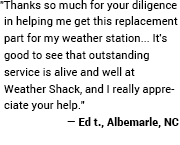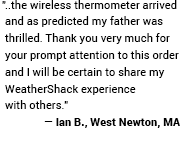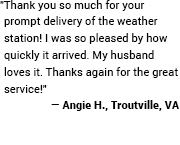
Anemometer
Installing A Wind Speed Sensor The goal of installing a wind speed meter (anemometer) is to position it in a location where the wind flows freely and is not influenced by nearby objects. The World Meteorological Organization has set the international standard height for wind measurement devices at 10 meters (33 feet) above ground, with no obstructions at or above this level. Attaining this height can not only be difficult but expensive as well. For most home weather stations installations, striking a compromise is likely the best alternative. So what are your alternatives? Part of the answer to that is how accurate you want your measurements to be? Wind observations taken at 7 meters (23 feet) are accurate enough for the National Weather Service to accept. For a rooftop installation, the minimum height to avoid anomalous winds caused by the roof itself is 3 meters (10 feet) above the most exposed part. Accuracy of the wind speed indicator is not just a matter of height. Local obstructions like nearby mature trees, houses and buildings all have the potential of impacting anemometer readings. Unfortunately this is the reality of taking wind measurements and the choice of how to deal with it is ultimately yours. Other requirements for the proper installation of an anemometer include mounting the mast absolutely vertical and orienting the wind direction indicator to true north for accurate wind direction readings. The mast can easily be leveled using a carpenter's bubble level, but orientation to true north is a bit more problematic. The best way to locate magnetic north is by using a magnetic compass and correct to true north by the magnetic declination for your area. Visit the National Geophysical Data Center (NGDC) page that will calculate it for your location. Do not use a GPS to make the determination, the magnetic compass is a more accurate tool to determine true north. If you need to brush up on magnetic declination, visit Wikipedia. |
Before erecting a tower or mast for your anemometer, check for possible height restrictions set by local ordinances and homeowner's association covenants. It would be unfortunate to have to take it down after installation. When selecting your mounting system, take into consideration that you will occasionally need to access the anemometer for preventive maintenance and possible component replacement. If the mast is roof mounted, position the supporting structure in an area that won't jeopardize roof construction. High winds and icy precipitation can place significant stress on the mast assembly so make sure the installation is sturdy. Be aware also that any elevated metal pole can act as a lightning rod so be sure to ground it properly. Failure to do so could be deadly. Be extremely careful when installing the anemometer and follow all procedures recommended by the manufacturer. Use caution and common sense, Safety First! Consider asking a friend to help out; it will make the job safer and easier. Always keep in mind the danger of falling or coming into contact with power lines. Likewise, make absolutely certain that your mast will not come into contact with power lines if it falls. And never work on your wind speed meter during slippery conditions or in strong winds. All content on the WeatherShack Education Center is Copyright 2002-2020 WeatherShack.com. This material may not be reproduced, displayed, modified or distributed without the express prior written permission of WeatherShack.com. For permission, please contact [email protected]. |
















